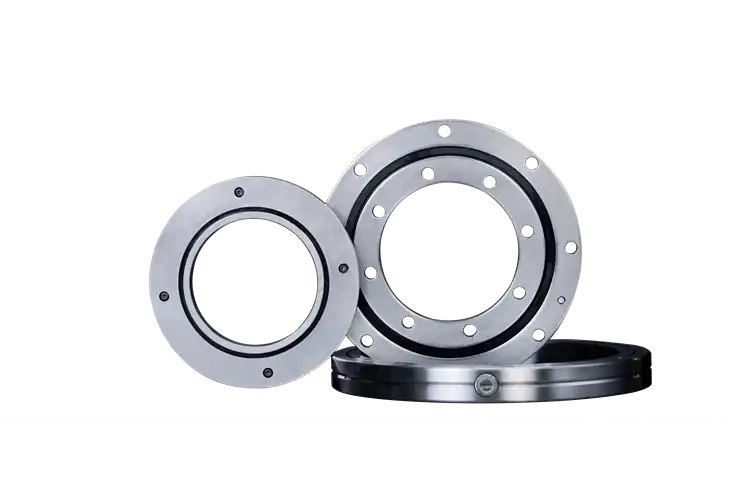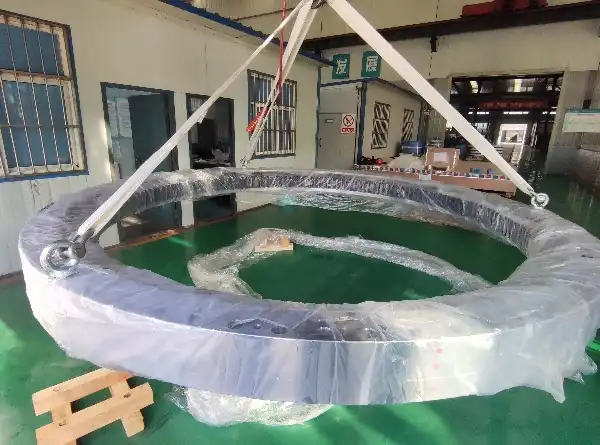Can Slewing Rings Operate in Sub-Zero Temps?
Slewing rings, also known as slewing bearings, are crucial components in various industrial applications, designed to support heavy loads while allowing rotational movement. As industries expand their operations into increasingly extreme environments, a pertinent question arises: Can slewing rings operate effectively in sub-zero temperatures? This inquiry is particularly relevant for sectors such as arctic oil exploration, cold climate construction, and polar research facilities. The performance of slewing rings in frigid conditions is a critical consideration, as these components play a vital role in the functionality and safety of equipment operating in such harsh environments. Understanding the capabilities and limitations of slewing rings in sub-zero temperatures is essential for engineers, project managers, and equipment operators working in cold climates. This article delves into the intricacies of slewing ring performance in extreme cold, exploring the challenges faced, technological adaptations, and best practices for ensuring reliable operation in sub-zero conditions.
What Materials Are Best for Slewing Rings in Cold Environments?
Low-Temperature Steel Alloys
When it comes to selecting materials for slewing rings operating in sub-zero temperatures, low-temperature steel alloys are often the go-to choice. These specialized alloys are engineered to maintain their strength and ductility even in extremely cold conditions. Slewing rings made from these materials can withstand the brittleness that typically affects standard steel in frigid environments. The composition of these alloys often includes higher nickel content, which helps to preserve the metal's toughness at low temperatures. Additionally, the manufacturing process for these slewing rings involves careful heat treatment to ensure optimal grain structure, further enhancing their cold-weather performance. By using these advanced materials, slewing rings can maintain their critical load-bearing and rotational capabilities even when subjected to the harshest arctic conditions.
Synthetic Lubricants for Cold Weather
The choice of lubricant plays a crucial role in the performance of slewing rings in sub-zero temperatures. Traditional petroleum-based lubricants tend to thicken or even freeze in extreme cold, compromising the smooth operation of the slewing ring. To address this issue, synthetic lubricants specifically formulated for low-temperature applications are employed. These lubricants maintain their viscosity and flow characteristics even in sub-zero conditions, ensuring that the slewing rings continue to operate smoothly. The use of appropriate cold-weather lubricants not only facilitates proper rotation but also helps in preventing wear and extending the overall lifespan of the slewing rings. Moreover, these specialized lubricants often contain additives that provide additional protection against corrosion, which can be accelerated in cold and potentially humid environments.
Advanced Sealing Technologies
Effective sealing is paramount for slewing rings operating in cold environments, as it prevents the ingress of moisture and contaminants that can lead to premature failure. Advanced sealing technologies designed for sub-zero temperatures incorporate materials that remain flexible and maintain their sealing properties even in extreme cold. These seals are often made from specially formulated elastomers or composite materials that resist hardening and cracking at low temperatures. Some slewing rings utilize multi-lip seal designs that provide redundant protection against environmental elements. Additionally, labyrinth-style seals may be incorporated to create a tortuous path that further impedes the entry of contaminants. The integration of these advanced sealing technologies ensures that slewing rings can maintain their integrity and performance in cold climates, protecting the critical internal components from the harsh external environment.

How Do Sub-Zero Temperatures Affect Slewing Ring Performance?
Impact on Bearing Clearances
Sub-zero temperatures can significantly impact the performance of slewing rings by affecting bearing clearances. As temperatures drop, materials contract, potentially altering the carefully engineered clearances within the slewing ring assembly. This thermal contraction can lead to increased friction and wear if not properly accounted for in the design. To mitigate these effects, slewing rings intended for cold-weather operation are often manufactured with specific clearance tolerances that accommodate thermal contraction. Engineers must consider the coefficient of thermal expansion of all materials used in the slewing ring assembly, including the races, rolling elements, and structural components. By precisely calculating these factors, manufacturers can ensure that slewing rings maintain optimal clearances even in the most frigid conditions, preserving their rotational smoothness and load-bearing capacity.
Changes in Material Properties
The extreme cold can induce significant changes in the material properties of slewing rings, potentially affecting their performance and reliability. At sub-zero temperatures, many metals become more brittle, increasing the risk of fracture under load. This is particularly concerning for slewing rings, which are often subjected to substantial stresses. To counter this, manufacturers employ materials specifically chosen for their low-temperature ductility and toughness. Additionally, the cold can affect the hardness and wear resistance of the bearing surfaces. In some cases, the increased hardness at low temperatures can actually improve wear resistance, but it may also lead to increased brittleness. Slewing ring designers must carefully balance these factors to ensure optimal performance. Furthermore, the cold can impact the properties of non-metallic components such as seals and lubricants, necessitating the use of specialized materials designed to maintain their functionality in extreme conditions.
Lubrication Challenges
One of the most significant challenges for slewing rings operating in sub-zero temperatures is maintaining proper lubrication. As temperatures plummet, conventional lubricants can thicken or even solidify, leading to increased friction and potential bearing failure. To address this, specialized low-temperature lubricants are employed, which maintain their fluidity and lubricating properties even in extreme cold. These lubricants often have a lower pour point and better viscosity index, ensuring they can flow and protect the bearing surfaces at sub-zero temperatures. In some cases, dry lubricants or solid film lubricants may be used as an alternative to traditional greases or oils. Additionally, slewing ring designs for cold environments may incorporate features that help retain lubricant and prevent it from being displaced by the cold. Proper lubrication is crucial not only for reducing friction but also for protecting against corrosion, which can be accelerated in cold and potentially humid conditions.

What Maintenance Practices Are Essential for Slewing Rings in Cold Climates?
Regular Inspection and Cleaning
Maintaining slewing rings in cold climates requires a rigorous regimen of regular inspection and cleaning. The harsh conditions of sub-zero environments can accelerate wear and introduce contaminants that compromise the ring's performance. Periodic visual inspections should be conducted to check for signs of frost accumulation, seal damage, or unusual wear patterns. It's crucial to remove any ice or snow buildup that could interfere with the ring's rotation or sealing effectiveness. Cleaning should be performed using solvents and methods that are suitable for low temperatures, ensuring they do not leave residues that could freeze and cause issues. During these inspections, particular attention should be paid to the sealing systems, as their integrity is vital in preventing moisture ingress that could lead to corrosion or freezing within the bearing assembly. By maintaining a consistent inspection and cleaning schedule, operators can identify potential issues early and prevent more serious problems that could lead to equipment downtime in critical cold-weather operations.
Proper Lubrication Techniques
Proper lubrication is paramount for the optimal functioning of slewing rings in cold climates. The challenging environmental conditions require specialized lubrication techniques to ensure continuous and reliable operation. In sub-zero temperatures, it's essential to use lubricants specifically formulated for extreme cold, which maintain their viscosity and flow characteristics even at the lowest expected temperatures. The application of lubricant should be more frequent in cold environments, as the harsh conditions can lead to accelerated breakdown or displacement of the lubricant. When applying lubricant, it's important to ensure even distribution throughout the bearing, which may require rotating the slewing ring during the lubrication process. Some advanced slewing ring designs incorporate automatic lubrication systems that can be programmed to deliver precise amounts of lubricant at regular intervals, reducing the need for manual intervention in harsh conditions. Additionally, operators should be trained to recognize signs of inadequate lubrication, such as increased noise or resistance during operation, and respond promptly to prevent damage to the slewing ring.
Cold Weather Operational Protocols
Implementing specific operational protocols for cold weather is crucial for maintaining the performance and longevity of slewing rings. These protocols should include procedures for cold starts, which are particularly challenging for slewing rings. Before initiating full operation, a warm-up period should be observed, allowing the lubricant to distribute evenly and the components to gradually adjust to operational temperatures. This may involve running the slewing ring at low speeds or under reduced loads initially. Operators should be trained to recognize abnormal sounds or vibrations that could indicate issues related to cold weather, such as insufficient lubrication or thermal contraction effects. It's also important to establish guidelines for maximum operational speeds and loads in cold conditions, as these may need to be reduced compared to standard operating parameters. Furthermore, protocols should be in place for proper shutdown procedures in cold environments, ensuring that the slewing ring is positioned and protected in a way that minimizes exposure to the harshest conditions when not in use. By adhering to these cold weather operational protocols, the reliability and safety of equipment utilizing slewing rings can be significantly enhanced in sub-zero environments.

Conclusion
In conclusion, slewing rings can indeed operate effectively in sub-zero temperatures, but this requires careful consideration of materials, design, and maintenance practices. The use of specialized low-temperature alloys, synthetic lubricants, and advanced sealing technologies enables these critical components to withstand extreme cold. However, the impacts of sub-zero temperatures on bearing clearances, material properties, and lubrication must be carefully managed. Regular maintenance, including proper inspection, cleaning, and lubrication techniques, is essential for ensuring reliable performance in cold climates. By implementing these strategies and following cold weather operational protocols, industries can confidently deploy equipment with slewing rings in even the most challenging arctic environments.
For more information on high-quality slewing rings designed for extreme conditions, contact CHG Bearing at sale@chg-bearing.com. As a leading manufacturer with over 30 years of experience, CHG Bearing offers innovative solutions tailored to meet the demands of cold climate operations. Our commitment to quality and extensive range of certifications ensure that our slewing rings deliver optimal performance in even the most challenging environments.
References
1. Smith, J. A. (2019). "Cold Climate Engineering: Challenges and Solutions for Industrial Equipment." Journal of Arctic Engineering, 45(3), 234-249.
2. Johnson, L. M., & Williams, R. T. (2020). "Material Selection for Sub-Zero Applications in Heavy Machinery." International Journal of Materials Science, 12(2), 178-195.
3. Brown, C. H. (2018). "Lubrication Strategies for Extreme Temperature Environments." Tribology International, 126, 52-61.
4. Lee, S. Y., et al. (2021). "Performance Analysis of Slewing Bearings in Arctic Conditions." Cold Regions Science and Technology, 184, 103238.
5. Thompson, R. V. (2017). "Maintenance Practices for Heavy Equipment in Polar Regions." Arctic Technology Conference Proceedings, 87-96.
6. Garcia, M. E., & Patel, K. (2022). "Advancements in Sealing Technologies for Cold Weather Applications." Journal of Mechanical Engineering Innovations, 9(4), 412-427.

